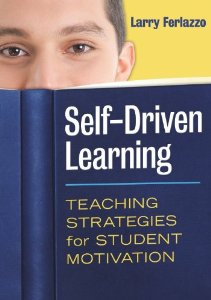Book Review: Self-Driven Learning

I am an informal educator. That is, I’m an educator with a focus on informal or “free choice” learning and public engagement with science. So it is a pleasure to say that, regardless of my informal education focus, Larry Ferlazzo’s new book on encouraging intrinsic motivation in students is an insightful and worthwhile sequel to his 2011 book Helping Students Motivate Themselves. His focus is on boosting student success inside and outside of the classroom, and extends beyond Common Core curricula to traits such as personal responsibility and perseverance.
Ferlazzo’s thesis is that encouraging students to be intrinsically motivated will do more for their education and life-long achievement than extrinsic motivation (such as rewards for achievement benchmarks or punishments). He notes that extrinsic motivators aren’t always bad, but compares the carrot-and-stick approach to education to Goethe’s story of The Sorcerer’s Apprentice – an easy shortcut that produces unintended consequences. He points to research that shows that, other than baseline extrinsic motivators such as competent teachers and a safe environment, “extrinsic rewards might work in the short term for mechanical tasks that don’t require much higher-order thinking. But research shows that points, prizes, and presents don’t tend to produce true motivation for any work that requires higher-order thinking skills and creativity.” He argues that, instead of focusing on accountability, we should focus on the bigger picture of how to make kids care about learning and want to learn.
To that end, Ferlazzo provides practical suggestions and detailed lesson plans to help encourage intrinsic motivation in students, including how to handle issues of classroom management, help students feel more positive about school and learning, develop higher-order thinking skills, and be more interested in reading and writing (Ferlazzo is an English teacher). The book ends with a chapter on how to prepare students for standardized tests “while doing no harm to them,” with suggestions on how to prepare students while covering meaningful content and avoiding “teaching to the test.”
Each lesson plan includes materials and time needed, step-by-step instructions, printables for the overhead or document projector (available as PDF downloads from the book’s website) and links to suggested additional resources available online. Ferlazzo highlights how each lesson plan aligns with Common Core English Language Arts standards, how assignments can be assessed, and possible extensions. Lesson plans can be found in each chapter, along with research-based suggestions for both “immediate actions” teachers can take to encourage intrinsic motivation and a positive learning environment, and suggestions for “setting the stage” for long-term changes in the classroom.
Although I probably won’t have the opportunity to use the lesson plans as provided, each is based on Ferlazzo’s clearly-presented ideas and suggestions for encouraging self-driven learning and I can easily think of ways to adapt them for free choice learning environments. I appreciate Ferlazzo’s practical, well-organized, and research-based approach to this book. Reading it felt like a friendly tour through a toolbox of techniques teachers (and educators of all sorts) can apply and experiment with. Sprinkled liberally with references to teaching resources and research, there is a treasure trove of further reading I can follow up on, but more importantly, I am left with practical suggestions I can put to use today to encourage intrinsic motivation in students of all ages.
Self-Driven Learning: Teaching Strategies for Student Motivation
Larry Ferlazzo
2013, Eye on Education





Larry Ferlazzo
Winifred,
The kind review is greatly appreciated!
Larry